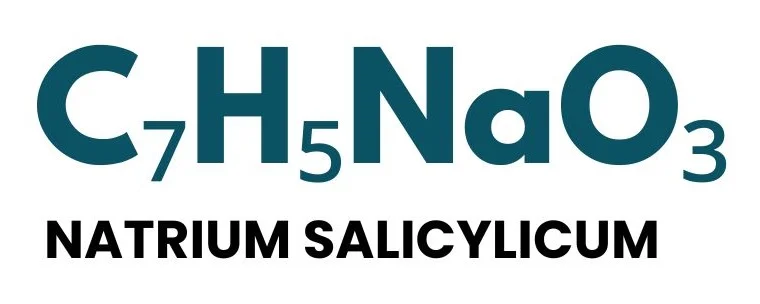Natrium Salicylicum, derived from salicylic acid found in plants like willow bark, is a potent remedy known for its impact on inflammation and pain relief.
Used extensively in homeopathy and traditional medicine, it targets issues affecting the head, ears, throat, kidneys, and liver.
Effective for conditions ranging from nosebleeds and vertigo to Meniere’s disease and influenza after-effects, it also addresses skin ailments like hives and oedema.
This sodium salt offers relief with its third potency dosage, recommended for various acute symptoms.
Explore its therapeutic benefits and historical significance in treating a spectrum of health concerns.

Table of Contents
ToggleSOURCE INFORMATION
Scientific Classification
- Kingdom: Plantae (source from Salix genus for salicylates)
- Family: Salicaceae
- Chemical Formula: C₇H₅NaO₃
Origin and Historical Facts
- Origin: Natrium Salicylicum is a sodium salt of salicylic acid, commonly derived from plants such as willow bark (Salix species).
- Historical Facts: Salicylic acid was historically used for its anti-inflammatory and pain-relieving properties.
- It has been synthesized in various forms for medical use, including the well-known aspirin.
- The sodium salicylate form is particularly effective for conditions involving inflammation and pain, as well as for treating metabolic issues and infections.
DRUG PATHOGENESIS
- Natrium Salicylicum primarily impacts the head, ear, throat, kidneys, and liver.
- It is known for treating hemorrhages, especially nosebleeds (epistaxis), and has significant effects on the internal ear, making it useful in conditions like Meniere’s disease.
- It also helps in alleviating symptoms following influenza, including fatigue, drowsiness, and tremors.
KEY CHARACTERISTICS
- Head: Rational periods alternating with insanity, vertigo (worse on raising the head), objects moving to the right, dull headache, and confusion.
- Eyes: Retinal haemorrhage, albuminuric retinitis with haemorrhage, iridocyclitis due to trauma.
- Ears: Tinnitus (low tone), deafness, auditory vertigo.
- Chest: Dyspnea with noisy, shallow breathing, irregular pulse, and complete loss of voice.
- Skin: Edema, urticaria, tingling and itching, pemphigoid eruption.
DETAILED ORGAN SYMPTOMS
MIND
- Alternating rational and insane periods.
- Somber insanity manifestations.
- Lassitude, drowsiness, listlessness, and tremors.
- Early stages of dementia.
HEAD
- Vertigo, worse when raising the head.
- Objects seem to move to the right.
- Dull headache and mental confusion.
- Fibrositis of the scalp (inflammation of fibrous tissue).
EYES
- Retinal haemorrhage, particularly in cases of albuminuric retinitis.
- Iridocyclitis (inflammation of the iris and ciliary body) due to trauma and secondary infections.
EARS
- Low-tone tinnitus (ringing in the ears).
- Deafness and auditory vertigo (dizziness related to ear conditions).
CHEST
- Dyspnea (difficulty breathing) with noisy, shallow, panting breaths.
- Irregular pulse and complete loss of voice.
SKIN
- Oedema (swelling) and urticaria (hives) with red, circumscribed patches.
- Tingling and itching sensations.
- Pemphigoid eruption (a type of blistering skin disease).
MODALITIES
- Worse: Raising the head.
RELATIONSHIP WITH OTHER DRUGS
- Compare with: Lobelia purpurascens, Gaultheria (Gaulth), China, and Pyrus malus (Crab apple tree) for similar symptoms and conditions.
- Non-Homeopathic Uses: In allopathic medicine, it is used for acute articular rheumatism, lumbago, sciatica, and to alleviate dysmenorrhea pain and promote menstrual flow.
DOSE
- Potency: Typically administered in the third potency.
- Non-Homeopathic Doses: Usual doses for acute conditions are 10 to 20 grains every three hours, with caution due to potential kidney tissue damage.
Frequently Asked Questions (FAQs)
What conditions can Natrium Salicylicum treat?
- It is used for treating head, ear, throat, kidney, and liver issues, including hemorrhages, vertigo, deafness, Meniere’s disease, influenza after-effects, and skin conditions.
How does Natrium Salicylicum affect the ears?
- It addresses tinnitus, deafness, and auditory vertigo, making it effective for conditions like Meniere’s disease.
What are the key symptoms indicating the need for this remedy?
- Key symptoms include vertigo, tinnitus, retinal haemorrhage, dyspnea, irregular pulse, oedema, and urticaria.
What potency is commonly used for this remedy?
- The third potency is typically used for Natrium Salicylicum.
Meaning of Difficult Words
- Hemorrhages: Excessive bleeding.
- Epistaxis: Nosebleed.
- Vertigo: Dizziness.
- Tinnitus: Ringing or buzzing noise in the ears.
- Dyspnea: Difficulty breathing.
- Oedema: Swelling caused by excess fluid.
- Urticaria: Hives or skin rash.
- Pemphigoid: A blistering skin condition.
- Iridocyclitis: Inflammation of the iris and ciliary body.
- Retinitis: Inflammation of the retina.
- Albuminuric: Related to the presence of albumin in the urine, indicating kidney disease.
This detailed drug picture for Natrium Salicylicum provides a comprehensive understanding of its therapeutic uses, key symptoms, and applications in homeopathy.
